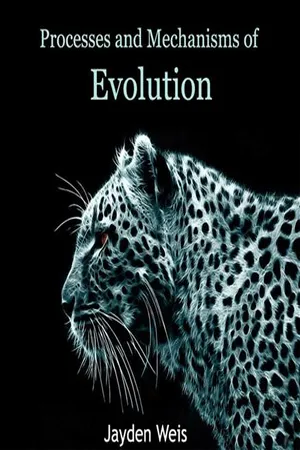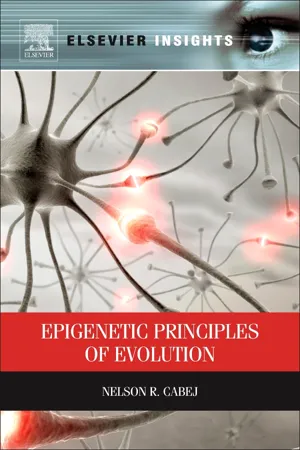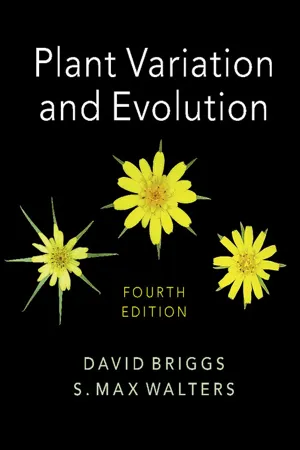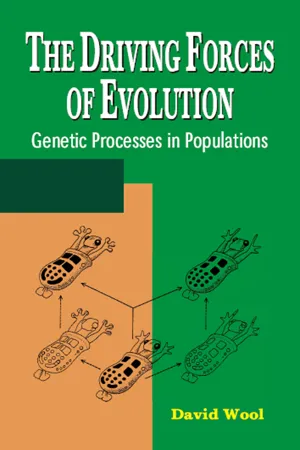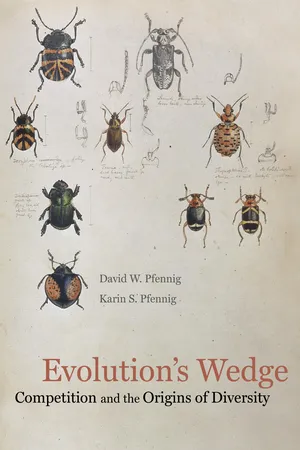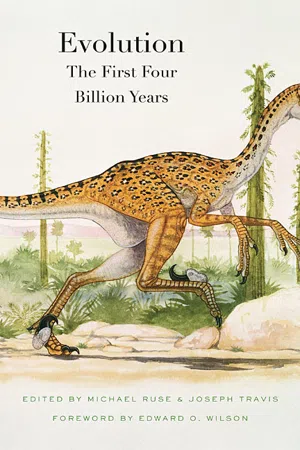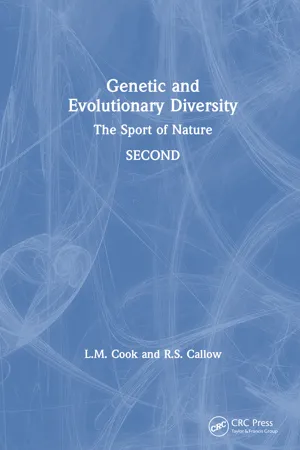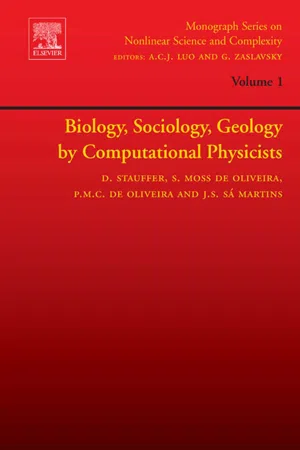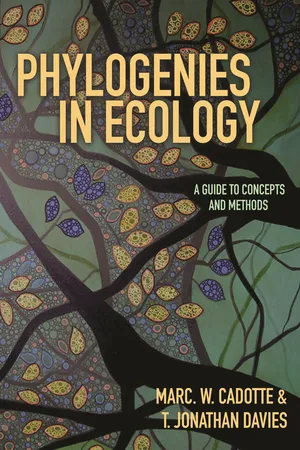Biological Sciences
Allopatric Speciation
Allopatric speciation is the process by which new species evolve from a common ancestor due to geographic isolation. It occurs when a population is divided by a physical barrier, such as a river or mountain range, preventing gene flow between the separated groups. Over time, genetic differences accumulate, leading to the formation of distinct species.
Written by Perlego with AI-assistance
Related key terms
1 of 5
12 Key excerpts on "Allopatric Speciation"
- No longer available |Learn more
- (Author)
- 2014(Publication Date)
- The English Press(Publisher)
Allopatric isolation is a key factor in speciation and a common process by which new species arise. Adaptive radiation, as observed by Charles Darwin in Galapagos finches, is a consequence of Allopatric Speciation among island populations. Isolating Mechanisms Comparison of allopatric , peripatric, parapatric and sympatric speciation Allopatric Speciation may occur when a species is subdivided into two genetically isolated populations. Allopatric and allopatry are terms from biogeography, referring to organisms whose ranges are entirely separate such that they do not occur in any one place together. If these organisms are closely related (e.g. sister species), such a distribution is usually the result of Allopatric Speciation . Separation may be attributed to either geological processes or population dispersal. Geographical isolation Geological processes can fragment a population through such events as emergence of mountain ranges, canyon formation, glacial processes, the formation or destruction of land bridges, or the subsidence of large bodies of water. On a global scale, plate tectonics is a major geological factor leading to separation of populations and the resulting distribution of species. Approximately 50,000 years ago, the Death Valley region of the western United States had a rainy climate which produced an interconnecting system of freshwater rivers and ________________________ WORLD TECHNOLOGIES ________________________ lakes. Climatic changes resulted in a drying trend that has continued for the last 10,000 years. As the lakes and rivers shrunk, fish populations became geologically isolated. The few remaining (separated) springs are currently home to a variety of fish, many sharing a close common ancestor; yet each has uniquely adapted to its own particular pool. The extent to which a geological barrier can effectively isolate a population correlates to the mobility of the organism or its offspring. - eBook - ePub
- Nelson R Cabej, Nelson R. Cabej(Authors)
- 2011(Publication Date)
- Elsevier(Publisher)
necessary condition for genetic and reproductive isolation. Thus, the emerging allopatric model of speciation, almost by consensus, was recognized as the predominant, if not the exclusive, way of speciation.Allopatric Speciation has been considered to be the most important form of speciation by most evolutionary biologists (Bush, 1975 ) and “the exclusive mode of speciation among birds and mammals” (Mayr, 2001 ).Now, most biologists believe that Allopatric Speciation has played a bigger role in the speciation and formation of higher taxa than sympatric speciation (Turelli et al., 2001 ), with the latter only recently having attracted serious attention and stimulated intensive research in evolutionary biology.Allopatric Speciation implies formation of new species via reproductive isolation that results from spatial separation (e.g., separation of lakes by newly emerging stripes of land, geological depressions that may separate a continuous territory into islands, migration into new islands, formation of glaciers, or course change of rivers) of the population of a single species in two or more populations, thus leading to divergent changes in their gene pools and rise of postzygotic reproductive barriers. In Ernst Mayr’s view, allopatry or geographic isolation is a critical condition for the speciation process to begin (Mayr, 1942 ).The spatial separation of populations, by preventing gene flow between them, leads to accumulation of divergent changes in genes and allele frequencies in those populations. These genetic differences can progress to such an extent that developmental incompatibilities leading to postzygotic isolation and reproductive isolation of geographically isolated populations may arise. When such populations come into contact again, only inviable hybrids, if any, will be produced. The loss of fertility of hybrids results in the reproductive isolation of the two populations that, according to the biological concept of species, from this stage on, represent two incipient species. This form of Allopatric Speciation determined by geographic isolation is considered by most neo-Darwinians as the predominant form of speciation in nature. - eBook - PDF
- David Briggs, S. Max Walters(Authors)
- 2016(Publication Date)
- Cambridge University Press(Publisher)
13 Allopatric Speciation and hybridisation In Chapter 12 we presented a simple model of gradual speciation. Two populations derived from a common ancestor and occupying different geographical areas (i.e. allopatric) pass through a period of independent change yielding derivatives that are reproductively isolated from each other. In such cases the existence of isolating mechanisms is revealed if the taxa come to occupy the same area (i.e. become sympatric). Allopatry may arise in many different ways. A comprehensive review of evolutionary plant geography, in relation to geological, climatological and historical factors, is presented in Chapter 17. Here, we note a few of the many possibilities, including vicariance and dispersal. ‘Vicariance is the appearance of a barrier that allows fragmentation of the distribution of an ancestral species, after which the descendent species may evolve in isolation’ (Morrone, 2009). For example, geographical isolation of daughter populations may result from the destruction of land bridges (e.g. the opening of the Irish and North Seas following post-glacial sea-level changes). In the longer geological perspective, vicariance events may be the result of major geological processes, such as continental drift and associated mountain-building. New isolated populations may also result from long- range dispersal of propagules to new territories, including ‘islands’ of different sorts, whether they be oceanic islands, isolated mountain peaks, landlocked lakes or areas associated with specialised rock types (e.g. serpentine). To take account of the complexities of different situations likely to be important in nature, a group of different models of Allopatric Speciation have been devised incorporating a range of assumptions (Grant, 1971; Levin, 2001b; Rieseberg, Church & Morjan, 2003; Rieseberg & Wendel, 2004; Bomblies, 2010; Rieseberg & Blackman, 2010). - eBook - ePub
The Driving Forces of Evolution
Genetic Processes in Populations
- David Wool(Author)
- 2006(Publication Date)
- CRC Press(Publisher)
speciation as a process of formation of reproductive barriers .Accordingly, natural populations in different levels of reproductive isolation – subspecies, sibling species and incipient species, as described above for Drosophila – are regarded as stages in the speciation process. Reproductive barriers were discovered between groups with no electrophoretic, chromosomal or morphological differences between them: speciation may be unrelated to the level of genetic variation in the groups (Templeton, 1981).GEOGRAPHIC (ALLOPATRIC) SPECIATION
A new species develops if a population which has become geographically isolated from its parental species acquires during its period of isolation characters which promote or guarantee reproductive isolation when the external barrier breaks down (Mayr, 1942, p. 155 ).Groups separated by geographical isolation are originally species only in posse. Their separation into good species is a subsequent process, accompanying the process of character divergence (Huxley, 1942, p. 383).The most common scenario for speciation begins with the separation of part of a previously-continuous population by a geographic barrier (Mayr, 1963; Bush, 1975; Ayala, 1975). The formation of a geographic barrier reduces or prevents gene flow between the separated subpopulations, which are then free to accumulate different mutations – making them progressively different from each other. Inbreeding and natural selection drive them farther apart, while the geographic barrier prevents mixing of the gene pools. If the barrier persists long enough, the subpopulations will become reproductively isolated from each other, and will not mix even if the barrier is removed: they have evolved into two separate species (Fig. 22.1A - eBook - PDF
Evolution's Wedge
Competition and the Origins of Diversity
- David Pfennig, Karin Pfennig(Authors)
- 2012(Publication Date)
- University of California Press(Publisher)
Indeed, laboratory experiments have demonstrated that independently evolving populations can evolve prezygotic isolating mechanisms purely as a side effect of being separated (Rice and Hostert 1993). Alternatively, physically separated populations may evolve postzy-gotic isolating mechanisms if they accumulate differences that cause reduced fitness owing to hybridization, as described in the previous section. This model of speciation — in which physically separated populations evolve repro-ductive isolation as an incidental by-product of the differences that accumulate between them when they are physically separated from one another — constitutes the allopatric model of speciation (Mayr 1942). Note, however, that allopatry is not the only biogeo-graphical context in which speciation can theoretically occur (Figure 8.3). A new species could also evolve either in a geographically contiguous population (parapatric specia-tion; Mayr 1942; Endler 1977; Gavrilets 2004) or within the geographical range of its ancestor (sympatric speciation; Maynard Smith 1966; Felsenstein 1981; Dieckmann et al. 2004; Gavrilets 2004; Bolnick and Fitzpatrick 2007; Nosil and Rundle 2009). Although the allopatric model of speciation is widely regarded as speciation’s most com-mon mode (Mayr 1942, 1963, 1970, 2001; Coyne and Orr 2004; Grant and Grant 2008; Price 2008; Futuyma 2009; Harrison 2010; Sobel et al. 2010), a growing number of researchers maintain that debates over the biogeographical setting of speciation are unproductive (see, for example, Butlin et al. 2008). Regardless of the biogeographical setting, any difference between populations will constitute an isolating mechanism if it precludes gene flow when members of those populations have the opportunity to interbreed (for example, during “secondary con-tact,” when populations come into sympatry after initially evolving in allopatry). - eBook - ePub
- Michael Heads(Author)
- 2016(Publication Date)
- CRC Press(Publisher)
Biological groups, especially close relatives, are often allopatric; that is, they occupy different areas. Allopatric groups may be separated by a gap (they are “disjunct”), but their distributions often meet without any obvious physical barrier between them. In other groups, the distributions overlap—they show varying degrees of sympatry. Biogeography needs to explain both allopatry and sympatry, but allopatry is a distinctive, fundamental phenomenon seen in most groups, and many authors have accepted its primary significance in evolution. Among the New Zealand gentians, for example, “allopatry is much more frequent than sympatry” (Glenny, 2004).Species ConceptsThe concept of species is controversial, and the particular concept that is used in a biological analysis is often regarded as critical. This book uses the species concept outlined by Darwin (1859: 32): “I look at the term species, as one arbitrarily given for the sake of convenience to a set of individuals closely resembling each other, and that it does not essentially differ from the term variety.” This is very different from the neodarwinian concept, in which species have a fundamental importance. In Darwin’s model, species are not regarded as special compared with groups at other ranks, above or below the species level (Heads, 2014). As Dennett (1996: 95) wrote, discussing the definition of species: “Where should we draw the line? Darwin shows that we don’t need to draw the line in an essentialist way to get on with our science… I am inclined to interpret the persisting debates [about species definitions] as more a matter of Aristotelan tidiness than a useful disciplinary trait.” Dobzhansky (1937: 312) argued in a similar vein: “Species is a stage in a process, not a static unit.” (In contrast, the neodarwinian view stressed that “a species is not a stage of a process, but the result of a process” [Mayr, 1942: 119].) - eBook - PDF
Evolution
The First Four Billion Years
- Michael Ruse, Joseph Travis, Michael Ruse, Joseph Travis(Authors)
- 2011(Publication Date)
- Belknap Press(Publisher)
However, for diverging populations whose ranges overlap (sympatry) or are adjacent to one another (parapatry), or when previously isolated allopatric populations come into contact (sec-ondary contact), intrinsic or extrinsic barriers to gene flow that prevent inter-breeding become necessary to complete the speciation process. Thus the importance of reproductive isolating barriers has been paramount in studies of speciation, and much of our understanding of the process of speciation is centered on the mechanisms that favor the evolution of reproductive isolation between species. Classic models of the speciation process focused on the geographic distri-bution of populations undergoing divergence and the relative contribution of geographic isolation to the formation of new species (Figure 4). Although the degree of geographic separation between diverging populations is certainly an important contributor to the disruption of gene flow, more recent studies of speciation have focused on the importance of evolutionary mechanisms (natural selection, sexual selection, genetic drift, and mutation) in promoting diversification and speciation either in allopatry or in sympatry. THE ROLE OF NATURAL SELECTION IN SPECIATION The importance of adaptive divergence in the speciation process (termed eco-logical speciation ) was first noted by the geneticist Theodosius Dobzhansky in the 1940s in describing speciation in Drosophila. Dobzhansky (1946) be-lieved that speciation in Drosophila occurred mainly through the evolution of divergent physiological complexes that were successful in different environ-ments. Ernst Mayr (1942) was the first to point out that many of the accumu-lated genetic differences between populations, particularly in physiological and ecological adaptations to particular environments, were also potentially reproductive isolating mechanisms. - eBook - ePub
Genetic and Evolutionary Diversity
The Sport of Nature
- Dr Robert Callow, Dr Laurence M Cook(Authors)
- 2023(Publication Date)
- CRC Press(Publisher)
In this very brief reference to a vast subject, we have identified three patterns of speciation − allopatric, parapatric and sympatric. They differ in the geographical scale on which speciation takes place. Allopatric Speciation requires geographical isolation, after which divergence takes place. Parapatric speciation assumes partial separation of subspecies adapted to different conditions, which then move to complete separation. Sympatric speciation would separate individuals into different niches within a single habitat. We have also identified two types of dynamic process responsible for species formation. The allopatric model depends on accidental separation, after which natural selection will modify the resulting taxa independently. Parapatric and sympatric speciation depend on disruptive selection accompanied by selection for reproductive isolation. In these two models, natural selection is central to the species-forming process.Chromosomal reorganization and polyploidy are both mechanisms whereby reproductive isolation may be effected or enhanced. Interspecific F1 hybrids are usually heterozygous for at least one structural change, often involving either a pericentric inversion or interchange. Most postulating isolation has a chromosomal basis; polyploidy is the major source in plants but its role in animal evolution is less obvious. Systems of premating isolation, based on behavioural differences, are less costly than those of postmating isolation but they can be less effective and more easily reversed. The narrowness of hybrid zones often testifies to the effectiveness of the chromosomal barrier, even when nuclear and cytoplasmic genes have introgressed well into foreign territory.Speciation is sometimes, but not always, directly involved with the process of increasing adaptation. Many workers would argue that allopatric species formation is the most common type. If so, species are continually coming into being by chance, to provide sets of isolated gene pools on which the evolutionary process may work.Table 16.2 Simplified diagram illustrating the history of the garden rose up until 195016.5 Two Genetic Models for Speciation
In the above descriptions, it is suggested that fitness depends on combinations of alleles at numerous different loci. The genetic homeostasis argument implies the same thing. We should expect to find that chromosomes accumulate particular sets of alleles which work well together, while other chromosomes have alternative sets. Individuals with different chromosome sets, or haplotypes, may then exhibit multiple heterozygote advantage. Loci on other chromosomes may then be fixed for particular alleles because they work well with the polymorphic complex concerned. Such a system, where there is a high degree of epistatic interaction between loci, is said to be coadapted. A lot of discussion of the possible course of evolution concerns the relative importance of adaptation. It is an essential feature of some hypotheses about the conditions which would promote or retard evolution. - Dietrich Stauffer, Suzana Maria Moss de Oliveira, Paulo Murilo Castro de Oliveira, Jorge Simoes de Sá Martins(Authors)
- 2006(Publication Date)
- Elsevier Science(Publisher)
If sexual selection is not in-cluded, competition will induce only a polymorphism (Sections 4.1.2 and 4.1.3 ) and the speciation process remains incomplete. The most important aspects of these computational models are that they offer the possibility of verifying whether speciation is likely to occur depending on different contingencies (which means that the outcome of two different simulations with identical parameters may de-pend strongly on the random number seed used in each one), and to measure the speciation velocity ( Figure 4.9 ) which, as already emphasised in Section 2.6 , is related to some critical exponent. The importance of fluctuations, absent in mean-field approaches, will appear again in the next section. 4.2. Parapatric speciation 129 4.2. Parapatric speciation As mentioned in the introduction of this chapter, Allopatric Speciation occurs when a physical barrier divides an original population into two geographically sepa-rated ones; in this case genetic drift and adaptation to the environment are the main ingredients for speciation. In case of sympatric speciation the two popula-tions inhabit the same region, and its most important ingredients are competition for resources and assortative mating. Parapatric speciation is an intermediate case where there is no physical barrier but there is a gradient of temperatures or altitudes, for example, across the same region (for a review see Gavrilets (2004) as well as Coyne and Orr (2004) ). The idea of traits being differentially adapted in different spatial locations is not new ( Endler, 1973; Lande, 1982; Sanderson, 1989; Kirkpatrick and Barton, 1997 ), although still under investiga-tion. The interesting question is how much does gene flow actually retard the development of geographic differentiation within a species.- eBook - PDF
Phylogenies in Ecology
A Guide to Concepts and Methods
- Marc W. Cadotte, T. Jonathan Davies(Authors)
- 2016(Publication Date)
- Princeton University Press(Publisher)
Hypothesis (2), the evolutionary explanation, assumes the divergence of ecological phe-notypes driven by mutually negative interaction as a response to selection acting to reduce competition; the result would be evolutionary character displacement (Brown and Wilson 1956, Taper and Case 1992). If we consider two populations of a single species (rather than two competing species), it is possible that competition for resources might be sufficient to drive speciation in sympatry (Diekmann and Doebeli 1999, Day and Young 2004), with divergent selection driving rates of character change (Schluter 2000, Coyne and Orr 2004). GEOGRAPHY OF SPECIATION • 123 Sympatric speciation remains a controversial topic and biogeographical evidence supports the predominance of a geographical (allopatric) mode of speciation (Mayr 1963, Lynch 1989). However, recent theoretical and empirical work has generated renewed interest in the subject (Turelli et al. 2001, Via 2001, Bolnick 2004, Coyne and Orr 2004). Alternatively, speciation may be allopatric; range shifts result in secondary sympatry and subsequent character displacement. The two cases may be represented as follows: a. Sympatry (incipient species) → ecological divergence → speciation (sympatric) b. Speciation (allopatric) → sympatry → ecological divergence Time flows from left to right; the arrows indicate direction of causality. Hypothesis (3), the ecological explanation, assumes speciation and ecological diver-gence occurs in allopatry; sympatry is the product of subsequent independent range shifts or dispersal over time. This case may be represented as follows: c. Speciation (allopatric) → ecological divergence → sympatry This last hypothesis is the closest match to assumptions underlying most analyses of phylogenetic community structure (e.g., chapter 3); but see Cadotte and Jin (2014). The mode of speciation can differentiate between case (a) and case (b) or (c). - Available until 27 Jan |Learn more
Eternal Ephemera
Adaptation and the Origin of Species from the Nineteenth Century Through Punctuated Equilibria and Beyond
- Niles Eldredge(Author)
- 2015(Publication Date)
- Columbia University Press(Publisher)
This, unbeknownst to me, is very close to one of Darwin’s two visions on how a law of adaptation would act, as developed in Notebook B (1837).the gradualistic view is at odds with accepted views of speciation derived from studies of the modern biota. And though undoubtedly phyletic transformation has no doubt led to the appearance of descendent taxa reasonably construed as new, descendant species [a view I have long since completely abandoned], nevertheless a model that allows for one or multiple speciation events during the same period of time would be the more satisfactory for the explanation of the diversity of life since the Cambrian. On probabilistic grounds alone, we must conclude that the overwhelming majority of metazoan species that have appeared on earth’s surface arose through some process of splitting. (156).I then discuss the preference among most biologists for the allopatric (geographic) model of speciation, in which a period of geographic isolation between conspecific populations is generally deemed necessary (though not in all cases wholly sufficient) for reproductive isolation to be established, and for new species to evolve. And I then “suggest that the allopatric model (geographic speciation) be substituted in the minds of paleontologists for phyletic transformism as the dominant mechanism of the origin of new species in the fossil record, and that the allopatric model, rather than gradual morphological divergence, is the more correct view of the processes underlying cases of splitting already documented by numerous workers” (1971a:156–157).After a brief discussion of environments of the Paleozoic shallow-water epicontinental (“cratonal”) seas, I then present a four-alternative description and analysis of the dominant evolutionary theories that have been routinely applied to explain the succession of non-intergrading, yet closely similar, and arguably ancestral/descendant species in the fossil record (figure 5.3 - eBook - ePub
- David A. Baum, Douglas J. Futuyma, Hopi E. Hoekstra, Richard E. Lenski, Allen J. Moore, Catherine L. Peichel, Dolph Schluter, Michael C. Whitlock, David A. Baum, Douglas J. Futuyma, Hopi E. Hoekstra, Richard E. Lenski, Allen J. Moore, Catherine L. Peichel, Dolph Schluter, Michael C. Whitlock(Authors)
- 2013(Publication Date)
- Princeton University Press(Publisher)
When diverging populations experience migration, successful differentiation is dependent on the strength of selection and the rate of gene flow between those populations. Migration between populations resulting in gene flow allows recombination to homogenize differences. It is therefore unlikely that uniform directional selection could result in the evolution of reproductive isolation between populations that exchange genetic material, because any universally adaptive mutation arising in one population would quickly be spread through all populations that exchange migrants. In contrast, divergent directional selection across habitats can result in reproductive isolation between populations even in the face of considerable migration. If selection is strong enough, regions of the genome that are involved in adaptations to different habitats will remain divergent. Conversely, alleles at neutral loci and alleles beneficial in both habitats will move between populations through migration, thus resulting in the homogenization of those regions of the genome.Sympatric populations and those that exchange large numbers of migrants are more likely to require disruptive selection to evolve reproductive isolation. Theoreticians have explored this scenario extensively in an effort to understand how speciation might occur in sympatry, despite gene flow. However, efforts to find examples of sympatric speciation in nature have yielded only a few compelling examples (see chapter VI.3 ).2. TYPES OF REPRODUCTIVE BARRIERS AND THE EFFECT OF SELECTION ON THEIR EVOLUTIONConsidering that there are many agents of selection in nature, it is not surprising that natural selection can contribute to the process of speciation in multiple ways simultaneously. As pointed out by Dobzhansky and Clausen, speciation most often involves multiple reproductive isolating barriers driven by a combination of evolutionary forces. Types of barriers are listed in chapter VI.1 . The contribution of natural selection to the evolution of those barriers is explained here.Habitat IsolationHabitat isolation is a barrier that reduces gene flow owing to adaptations of populations to divergent habitats. When populations become adapted to different habitats, individuals have a greater chance of surviving and mating in their native habitats compared with foreign ones. The reduced viability of immigrant individuals in the foreign habitat leads to a reduced rate of mating between native and foreign individuals. A classic example of habitat isolation occurs in Timena cristinae walking-stick insects. In California, populations of walkingsticks have become locally adapted to living on either Adenostoma fasciculatum plants or Ceanothus spinosus
Index pages curate the most relevant extracts from our library of academic textbooks. They’ve been created using an in-house natural language model (NLM), each adding context and meaning to key research topics.
